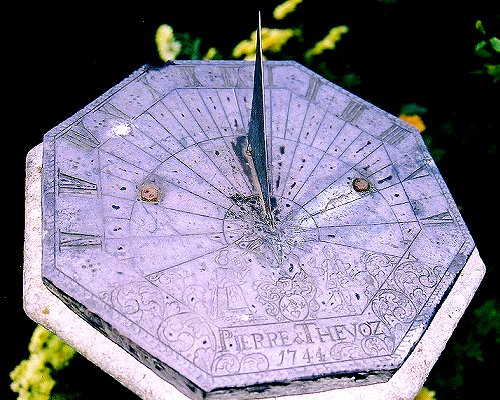
Convent garden, Maaseik (Belgium)
The garden lies behind the convent of the Crutched Friars in Pelserstraat. The convent building is kind of new, but the garden pretty old. When you pass the barrier (intended to prevent unauthorized parking) and enter the garden, you will be surprised to find such a spacious and quiet place right in the crowded, medieval city center. Two fascinating sundials can be found here.
Horizontal dial

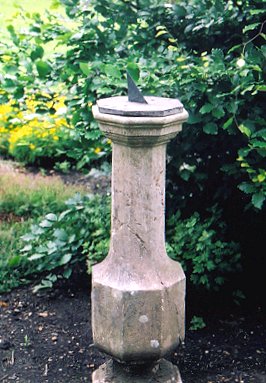 This horizontal garden dial is set more or less in front. The pole style is made of copper, the base is a piece of slate. The latter is engraved richly. The pole-style rises from a 'sunny face'. The hour lines and the half-hour lines further outward are crisp. Numbers run from VI to VI (18) hr, local time of course. The octagonal dial face is lined by a subtle decoration and has been signed: Pierre Thevoz, 1744.
This horizontal garden dial is set more or less in front. The pole style is made of copper, the base is a piece of slate. The latter is engraved richly. The pole-style rises from a 'sunny face'. The hour lines and the half-hour lines further outward are crisp. Numbers run from VI to VI (18) hr, local time of course. The octagonal dial face is lined by a subtle decoration and has been signed: Pierre Thevoz, 1744.
The hour numbers are very peculiar: the ones from VI to XII have been written in reverse. Between the numbers are half-hour marks, consisting of five dots.
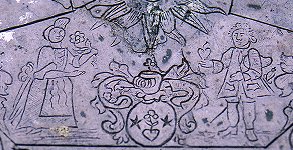 The dial face carries a beautiful engraving. At left a female figure carrying a flower and at right a male figure wearing a wig and carrying a heart. The flower and the heart, flanked by two five-pointed stars, are repeated on the coat of arms in the center. The sign of the wealthy family that once ordered the dial from Pierre Thevoz?
The dial face carries a beautiful engraving. At left a female figure carrying a flower and at right a male figure wearing a wig and carrying a heart. The flower and the heart, flanked by two five-pointed stars, are repeated on the coat of arms in the center. The sign of the wealthy family that once ordered the dial from Pierre Thevoz?
Location: 51.1° N, 5.8° E
Design: Pierre Thevoz (?)
Inauguration: 1744
Spherical dial
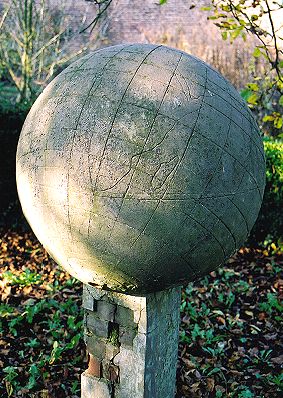
I find the second sundial not less interesting: a large terrella from 1953. It is located in the back of the garden, almost against the medieval city wall of Maaseik and in the shadow of a walnut tree. This dial did not resist the elements as well as the other; I left the holes in the back off the picture. It was constructed by Father geography teacher and is made from cement.
The contours of the continents are still visible. The continents once were green and the oceans blue, told us Father gardener. Meridians are traced per 15°, not starting from Greenwich, but - rightly so - from the Maaseik meridian. Parallels per 20°, as well as tropics and arctic circles. Finally the horizon circle. And a tube through the center of the globe allows one to see Polaris at night, according to Father gardener. Really an impressive design!
A small tool goes with the globe, a kind of table with a thin, perpendicular tube. One would slide it over the surface of the globe until the sun shines straight through the tube. At that spot on earth the sun is right in the zenith.
That is history now; the tree has grown too large. Fortunately it had lost most of its leaves when we visited, so the sphere caught at least some sunshine. You may vaguely see the terminator, which indicates the twilight zones on earth. Whether there has been a time scale at the equator, I could not see anymore.
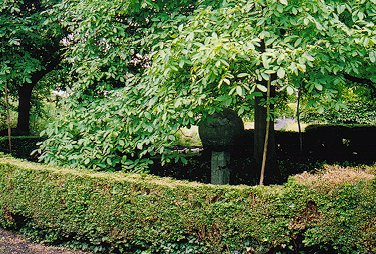
The tree is younger than the globe. The story goes that Father geography teacher was called to another convent. Then the tree was planted, presumably by the same Father gardener who showed us around. When Father geography teacher returned after many years and saw the mishap, it was too late to cut the tree down: the Fathers liked its walnuts too much.
Location: 51.1° N, 5.8° E
Design: Father A. van Dooren
Inauguration: 1953